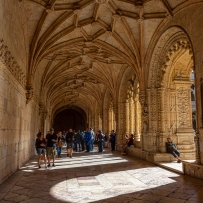Lisbon, Portugal’s capitol and largest city is bursting with culture, history and tourist attractions. The city is situated along the Tagus River very close to the Atlantic Ocean. This location by the sea is important to Lisbon’s rich history, the jumping off point for the Portuguese explorers in the Age of Discovery.
Lisbon is one of the oldest cities in Western Europe, having its origins as an indigenous Celts settlement around 800BC, also as Phoenician and Greek trading posts in the same era. Then occupied by Carthaginians and eventually become part of the Roman Empire as the city of Olisipo. After the fall of the Roman Empire, the Visigoth German tribes occupied much of the Iberian peninsular, including Portugal. The invasion and occupation by the Islamic Moors from North Africa in the 8th Century lasted about 4 centuries until they were ousted by Christian crusaders. The influence of the Moors is still very evident throughout Portugal in the beautiful ceramic tiles (azulejos) that adorn palaces, churches, public buildings, even homes.
In 1755 a massive earthquake and subsequent tsunami devastated Lisbon and the surrounding areas. The Secretary of the State of Internal Affairs at that time, Sebastião José de Carvalho e Melo, popularly known as the Marquis of Pombal, lead the bebuilding efforts. Pombal employed new building codes and methods including earthquake-proof architectural design. Much of what you see in central Lisbon today are the results of this 18th Century rebuilding effort. A large monument at the Praça Marquês de Pombal square honors the Marquis of Pombal.

We spent the first two days and the last two days of our trip in Lisbon. This gave us enough free time to do some walking around. Lisbon is a hilly city with cobblestone sidewalks and streets, so walking can be a bit challenging for us older folks. Lots of stairs and steep streets will ramp up your FitBit numbers rather quickly. We found the public transit system in Lisbon to be excellent and very affordable. On our last full day we purchased a 24-hour Metro pass (about 6.00 Euros each) which covered subway, buses and the famous street trams.
Some of the sights we visited included Belem Tower, Jerónimos Monastery, Praça do Comércio, St. George Castle, Lisbon Cathedral and Edward VII Park.
Enjoying Food & Drink
Making Pastel de Nata
Some visited sights
One of the interesting features of Lisbon is the extensive cobblestone paving of miles and miles of sidewalks. These cobblestones are small, irregular shaped and are hand fitted. On the sidewalk at the southeast corner of Praça dos Restauradores (Restaurant Square) there is a tribute of the pavers who build these extensive works of art.


















